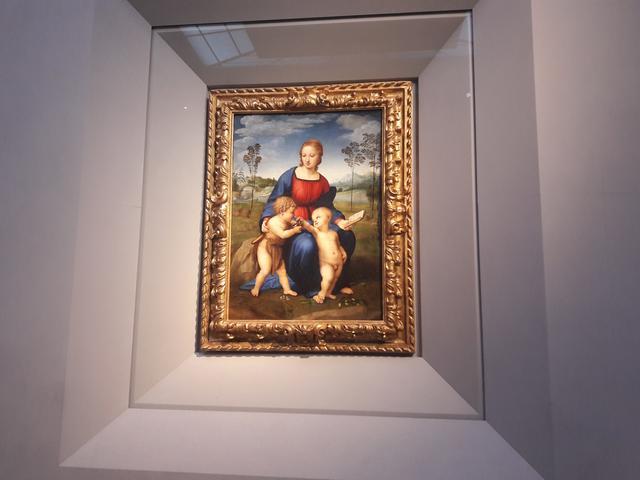Virgin of the Goldfinch

The Virgin of the Goldfinch is a painting by the Italian Renaissance artist Raphael, from c. 1505-1506. A 10-year restoration process was completed in 2008, after which the painting was returned to its home in the Uffizi. During the restoration, an old copy replaced the painting in the gallery.
In this painting, as in most of the Madonnas of his Florentine period, Raphael arranged the three figures, Mary, Christ, and the young John the Baptist, to fit into a geometric design. Although the positions of the three bodies are natural, together they form an almost regular triangle. The Madonna appears young and beautiful, as with Raphael's other Madonnas. She is also dressed in red and blue, also typical, because red means the passion of Christ and blue was used to mean the church. Christ and John are still very small, just babies. John has a goldfinch in his hand, and Christ reaches out to touch it. The background is typical of Rafael. The natural environment is diverse and yet it all calmly frames the central theme taking place.
The Madonna was a wedding gift from Rafael to his friend Lorenzo Nasi. On November 17, 1548, Nasi's house was destroyed by an earthquake and the painting was broken into seventeen pieces. It was immediately taken to be salvaged, and was quickly put back together, although the seams were quite visible. In 2002, George Bonsanti, of the Piedras Preciosas organization, entrusted the restoration task to Patrizia Riitano. During the six-year process that followed, his team worked to remove years of dirt that had degraded the paint color and to repair damage caused by the earthquake long ago. Before starting the project, they studied the work as closely as possible, using resources such as x-rays, CT scans, reflective infrared photography and even lasers. Riitano pored over the layers of quick repair from the past that had been applied and removed them until Raphael finally shined. The restoration was completed in 2008, and the painting was displayed at the Uffizi.
In Madonna del Cardellino, the goldfinch represents the crucifixion of Christ. The reason for their association comes from the legend that their red spot was born at the time of the crucifixion. It flew over the head of Christ and was removing a thorn from His crown, when it was splashed with the drop of His blood. The book in Mary's hand reads Sedes Sapientiae or The Throne of Wisdom. This term is usually applied to images in which Mary is seated on a throne, with Jesus on her lap, but in this case, the inscription implies that the rock on which Mary sits is her natural throne.
In some versions of Vasari, another similar painting is described as the Vallombrosa version, but it has never been identified.
© Tourblink